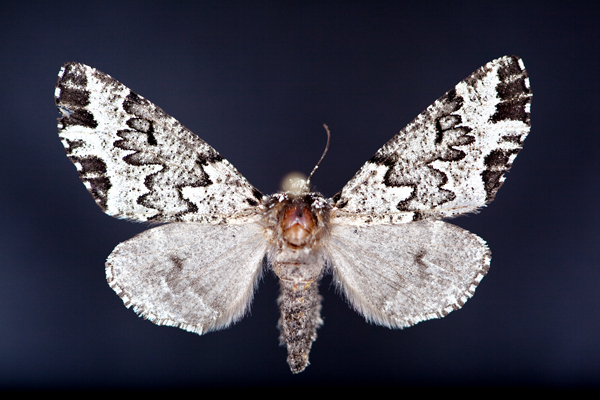A polilla deste luns é unha especie espectacular das montañas de Arizona – Chiricahua multidentata, unha xeométrica. O único lugar coñecido para esta especie atópase na parte superior das montañas Chiricahua 9,000 pés (que se acababa de dar un toque crujiente). Esperemos que o lume non fose totalmente devastador e que a poboación se recupere nos próximos anos. Antes 2009 esta avelaíña era coñecida de menos de 10 espécimes, todos capturados na elevación lixeiramente máis baixa en Onion Saddle nos Chiricahuas. Na primavera de 2009 o acceso a unha estrada pechada conduce á recollida de ducias de exemplares nunha soa noite. Todos os rexistros anteriores foran raros perdidos que baixaran ata os 8500′ – senón o simple feito de levar un extra 1000′ 500'colocou o colector no hábitat ideal e, sorprendentemente, esta polilla era común! Isto parece ser a par para a maioría dos insectos, moi poucos son realmente raros mentres que o resto son só difíciles de capturar. Ou non saen á luz, non buscar comida dentro do brazo, ou só viven en hábitats de difícil acceso. Unha vez que descubras a súa bioloxía (ou ter sorte) normalmente podes atopar o animal en abundancia.
Tamén podes ter notado a publicación habitual de Monday Moth – Estiven no campo as últimas dúas semanas e tiña unha chea de publicacións programadas. Debería comezar a mesturar máis as cousas agora!


Así, now you’ve got me wondering what this species depends upon (vegetation: food for self & progeny, shelter) and how that responds to fire…
Si, indeed, re: things that live near roads and trails SEEM v. common vs. things that avoid same. Reminds me of a story of an older gentleman who lived I think in Owens Valley?? My moth friend said this guy had seen a particular moth only when it was below 32 dF (forgive me if I’m repeating myself), I think 27 or so, and no body believed him. Then the guys went out to try and find it. 32 F, sen avelaíña. 30 F, sen avelaíña, 27 F, this moth starts flying around. Do you know this story and/or the moth?
=) Anyhow, thanks for the post of the lofty moth.
I’m not sure I’ve heard the exact story you’re recalling – but I know of lots of examples like this. I just collected a series of Gazoryctra wielgusi in Arizona and they only fly for 15 minutes between 7:45 e 8 (later in August they fly a little earlier, but still for 15 minutos). I actually set my alarm on my phone and the first moth flew in at 7:47 and the last one at 7:58. Amazing!
En realidade, even more subtle than this. The elevation difference is closer to 500 pés, and the vegetation looks very much the same at the higher location than down at Rustler Park/Onion Saddle
Thanks for the clarification!
Tira, super interesting (745 – 8).
Do you know the plant species your Monday Moth depends upon?
Officially the host plant is unknown – but one female did lay eggs on a pine stem when offered a large choice of local plants. The egg’s didn’t hatch, but it’s not too unreasonable to guess pine is preferred.